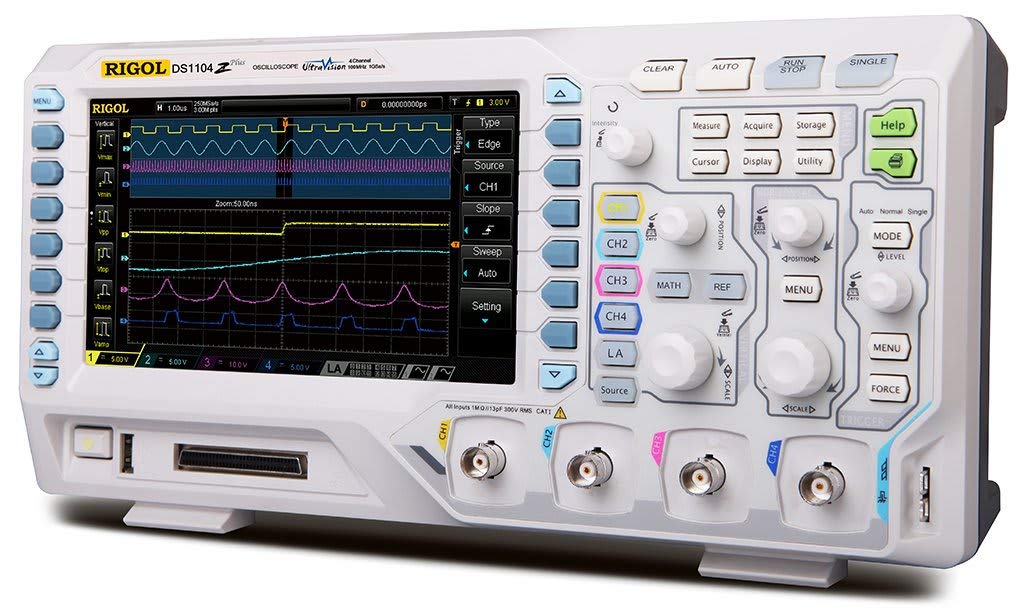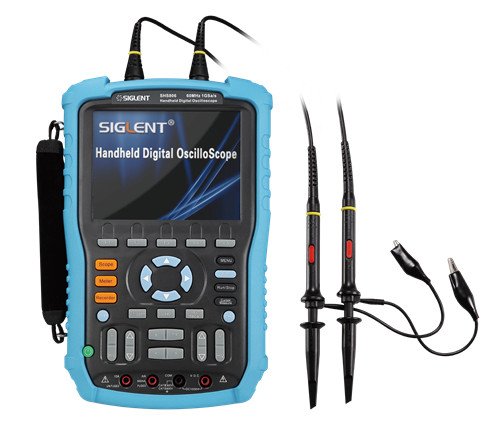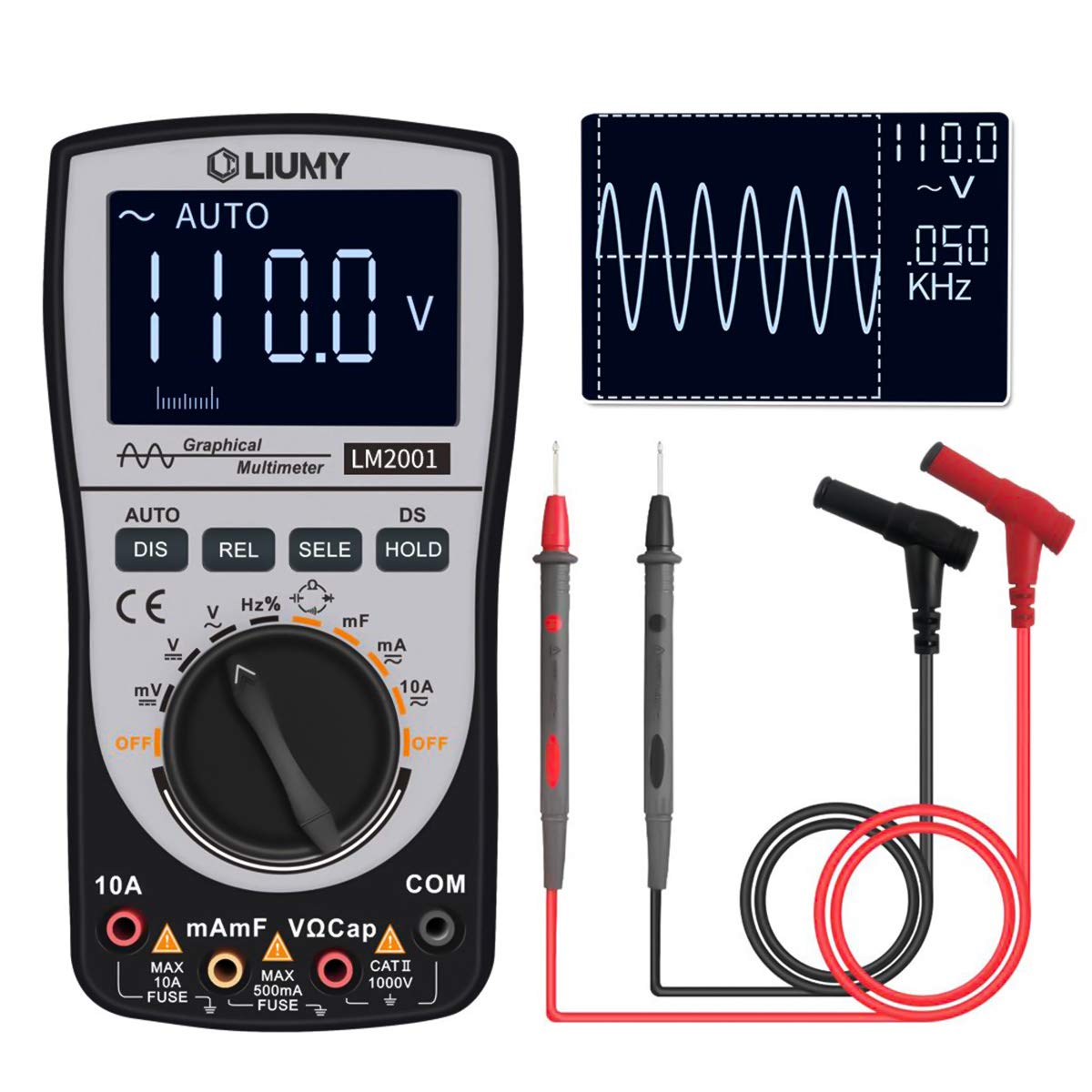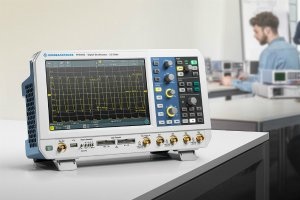Due to their high efficiency and versatile nature, oscilloscopes are being used in various fields nowadays. Some people use it as a crucial electronic lab device, while others employ it with the ECG machines to get an accurate result. However, not all oscilloscopes are the same. Hence, whether for use in a professional environment or personal use, you should always buy the best digital oscilloscope for the money.
However, if you are a beginner or new in this aspect, purchasing a good oscilloscope might get a little bit tricky for you. So, to narrow your list and help you with your choice, we have enlisted twelve different oscilloscopes here. Besides their names, this descriptive list also contains a separate pros and cons section to make everything more convenient for you.
So, if you do want to acquire the best portable Oscilloscopefor for your own cause, then make sure to read on.
Let’s get started.
Table of Contents
Best Digital Oscilloscope for the Money Reviews
1.Hantek DSO5102P Digital Storage Oscilloscope – best cheap Oscilloscope

When talking about the best cheap Oscilloscope in the market, the first name that comes to mind is Hantek DSO5102P. The model comes with a 100MHz of bandwidth and can achieve a sample rate of 1GSa/s.
Moreover, it also comes with the much-required trigger mode, which can help it capture any frequency a lot more quickly.
Another factor, which prompts most people to consider it as the best 100 MHz oscilloscope, is its large 7-inch display. Its high-end screen and WVGA resolution of 800×480 pixels can help you watch every detail clearly.
Furthermore, the Hantek DSO5102P model also has a memory depth of 40k, which boosts its sample rate even more.
The Hantek DSO5102P also has a USB host and features several automatic measurements to make things even more convenient for you.
- It has a bandwidth limit of 100MHz, which helps capture almost any type of electronic frequencies.
- It comes with a memory depth of 40k, which improves its sample rate by a mile.
- It features a well-designed and glossy 7-inch screen.
- The USB host lets the users connect the device with their PC
- It has two probe channels, which is perfect for beginners.
- The software includes this device, is quite slow.
2. Siglent SDS1104X-E 100Mhz Digital Oscilloscope – best Oscilloscope for beginners

Since its inception, Siglent has always offered high-quality oscilloscopes at an affordable price, and this product is a perfect example of it. Widely known as the best Oscilloscope for beginners, the device comes with a proficient four-channel series. With this excellent feature, it can achieve a waveform capture rate of 4,00,000 wfm/s.
There is also a Serial Bus Decoding Function available with this device, which helps it acquire protocol information quicker than usual. Furthermore, it also comes with an advanced SPO technology, which boosts its overall efficiency to some extent.
Broadly considered the best Oscilloscope for audio, Siglent SDS1104X-Ecomes with a separate USB Wi-Fi adapter. So, besides using it manually, you can also operate it through your computer.
- It features the coveted Search and Navigation function.
- It comes with a large TFT-LCD display, which helps the users to see everything clearly.
- The standard decoder boosts its overall convenience even more.
- With its bandwidth limit of 100MHz, it can easily capture even the most complex frequencies quite comfortably.
- It is easy to use
- It is not that durable.
3. Rigol DS1104Z Plus 100 MHz Digital Oscilloscope – best affordable oscilloscope

Like both the previous devices on this list, Rigol DS1104Z has a 100MHz bandwidth limit. Besides, it also has a 24 Mpt memory capacity, which helps it accomplish a 1GSa/sec sampling rate. With both of these excellent features, the Oscilloscope can achieve a waveform capture rate of 30,000wfms/sec.
Rigol has placed the source control button and analog channel ports in an easily-accessible position to make things more convenient for you. Moreover, like any other affordable oscilloscopes, this one comes with 16 different digital channels, which improves its efficiency even more.
However, like everything, before buying this device, make sure to check out the Rigol oscilloscope review to know more about it.
- With its high memory capacity and excellent bandwidth, it can acquire a high sampling rate.
- It comes with a free software bundle.
- It has a Digital Logic Connector, which helps in upgrading its MSO.
- Features 16 digital channels.
- Due to its lightweight design, it is also quite portable.
- Its display is quite small and looks somewhat stuffed.
- It is quite noisy.
4. Siglent SHS806TCAL Handheld Oscilloscope – best Oscilloscope for hobbyists

Are you looking for the best Oscilloscope for hobbyists? Then, this device from Siglent can be absolutely perfect for you. It comes with a 5.7”-inch TFT-LED screen, which can help you to see all the details quite clearly. Besides, as it comes with a popular handheld design, you can comfortably carry it around your pocket.
Unlike the other machines on this list, this one comes with advanced triggers. Hence, with it, you can trace the isolated signals quite comfortably. Moreover, it has a real-time sampling rate of 1GS/s and an overall record length of 2Mpts. It can help the Oscilloscope to collect up to 18 hours of waveforms without any issue.
- It has a 60MHz bandwidth limit, which helps it capture even the smallest signal lengths quite easily.
- It can acquire a real-time sample rate of 1GS/sec.
- With its record length of 2Mpts, it can accumulate waveforms for 18 hours.
- It comes with advanced triggers, which helps it to gather isolated signals quite easily.
- Its build quality is a little bit off to the mark.
5. Quimat Updated 2.4″ TFT Digital Oscilloscope Kit with Power Supply – Best Oscilloscope for Audio

If you do proper research, you will find many high-end handheld devices in the market. However, none of them can beat the Quimat Updated 2.4″ TFT Digital Oscilloscope regarding efficiency and effectiveness.
Unlike its previous version, this Quimat model comes with excellent sensitivity. Hence, when enabled, it can reach 5mV/div to 20V/div quite quickly. A rotary encoder is available with this device, which can help you adjust its parameters more quickly.
Widely considered the best digital Oscilloscope, this Oscilloscope also comes with three measurement modes. So, with only a flick of a switch, you can comfortably capture the current waveform.
Quimet has also added a basic button function system to make things more convenient for you. Hence, even if you are a beginner or do not know anything about the device, you can comfortably operate the Oscilloscope.
However, before you start, make sure to check the available kit thoroughly. If you miss out on something, then the device will not work properly.
- It comes with essential button functions, which makes it a lot more convenient.
- With its simple yet efficient measurement features, it can capture any wavelength quite effortlessly.
- It’s lightweight and, the handheld design enhances the portability of the product.
- With its waveform memory function, the users would not have to worry about losing the waveform after disabling the device.
- Has a robust build quality
- It makes a lot of electrical noise.
6. YEAPOOK Handheld Digital Mini Oscilloscope – best Oscilloscope for home use

There are various features, which make this YEAPOOK device the best Oscilloscope for home use. For starters, it comes with 100 MHz analog bandwidth and can achieve a sampling rate of 500MSa/s. Apart from that, its small yet compact design makes it more portable and helps you to hold it in your hand comfortably.
There is also a built-in 64 MB flash storage available in this model. With it, you can both capture and store more than 2000 waveform illustrations. Both the storing and saving procedures are quite simple in this device. So, if you are a beginner, then this device would be perfect for you.
The machine comes with a 2.4-inch colored TFT-LCD screen, which can generate 320×240 pixels of resolution. Therefore, even though the screen is quite small, you can comfortably see everything in it due to its vibrant resolution.
These are some of the reasons for making this YEAPOOK device the best selling oscilloscope inthe market.
- The device has a 100MHz bandwidth limit, which is quite rare in this price range.
- It offers easy measuring with its triple triggering function.
- Its flash storage can collect more than 2000 waveform images.
- Can achieve an average sampling rate of 500 MSa/s
- Its screen is quite small.
7. Analog Discovery 2: 100MS/s USB Oscilloscope – best Oscilloscope under 500

Broadly considered the best Oscilloscope under 500, the Analog Discovery 2 comes with two analog inputs and two outputs. It also has a two-channel USB port, which can help you connect it to your PC or laptop for a better experience.
Unlike other affordable devices, this one comes with a separate Software Development Kit, which consists of Python and C++ libraries. There is a script editor also available with this device. With it, the Oscilloscope can work with almost all the 3rd party software programs.
Like a few of the other oscilloscopes on this list, the Analog Discovery features an exquisite handheld design. However, as it is a little bit weightier than the others, you might face issues while handling it.
- It comes with a USB port, with which the users can connect it with a computer and a laptop.
- Its overall build quality is quite decent.
- Its compact design boosts both its movability and durability.
- The device features a data logger and script editor, which makes it more convenient and versatile.
- The users with smaller hands might experience handling issues due to their measurements and weight.
8. LIUMY Professional LED Handheld Oscilloscope – best Oscilloscope for Arduino

Are you looking for a highly efficient yet cheap oscilloscope? Then, this device from LIUMY can be the best option for you. Unlike most other products in this price range, this Oscilloscope has a high sampling speed. Hence, it can collect data and store them quite quickly and efficiently. Due to this reason, most people consider it to be the best Oscilloscope for Arduino.
To make its device more convenient and easy-to-use, LIUMY has also added a one-key transform function. Thanks to this feature, you can begin waveform function and measure them with only one flick of a switch.
Besides these, an LED backlight is available with this Oscilloscope to help work even during nighttime. It is yet another feature, which makes it the best cheap Oscilloscope for beginners.
- The device comes with a fuse protection function, which protects the fuse from high voltage issues.
- Features a LED backlight for more convenience
- Has a high and efficient detection range
- Its faster sampling speed can boost its overall efficiency by a mile.
- Its LCD screen is somewhat small.
- Misses out on a lot of modern features.
9. Hantek 2D72 3in1 Digital Oscilloscope – best handheld oscilloscope

When talking about the best Oscilloscope for the money, the first name that comes to mind is Hantek 2D72. It comes with a powerful18650mAHbattery, which is both replaceable and rechargeable. You can recharge it with both computer USB or high current chargers, such as 5V or 2A.
Another excellent factor about this device is its type C data transfer interface. With this feature, you can connect it with not only your PC but with your smartphone too. It also has an English and Chinese language. So, no matter which part of the world you belong to, you can use this Oscilloscope without any issue.
- It has a maximum sampling rate of 250MSa/s.
- It comes with a rechargeable and replaceable battery.
- Features an edge trigger function, which helps it to stabilize the electronic signals
- It comes with a much-required self-calibration function.
- Not compatible with high energy circuits.
10. Hantek 1008C 8CH Automotive Diagnostic PC Oscilloscope – best Oscilloscope for automotive

Are you on the lookout for the best Oscilloscope for automotive? Then, the Hantek 1008C would be perfect for you. It comes with eight different channels for testing every portion of your vehicle properly. Besides, it also has a USB 2.0 plug-and-play interface. So, it will not require any extra power supply to offer its services.
The Hantek 1008C comes with more than 15 different functions that can help you check your automobile thoroughly. However, it has a similar interface to a benchtop oscilloscope; you will not have any problems while using it.
Another factor, which prompts everyone to consider it as the low-cost oscilloscopeis its software-supportive capability. With this Oscilloscope, you can work on Windows NT, Windows 7, Windows 2000, Windows XP, and VISTA.
- It comes with eight analog channels for more convenience.
- Features a highly-efficient trigger system
- It has a memory depth of 4K, which increases its sampling rate to some extent.
- Can work comfortably with several software programs
- It comes with 20 different types of testing functions.
- Software issues might occur after heavy usage.
Final Verdict
So, these are some of the best oscilloscopes that you can find in the market. However, if you have come this far, you probably understand that each of these devices works differently, in different ways. If you want to find out the best for you, then make sure to try a proper oscilloscope comparison. Besides, to get a better idea and buy the ideal product, you can also read the pc based oscilloscope reviews.
Factors to consider while buying a digital oscilloscope
In this market, purchasing the best digital Oscilloscope can be difficult for almost anyone. However, if you keep a few things in your mind, then the task of buying an oscilloscope would become a lot easier for you. The following are some of them.
Display and Design
Almost every digital storage oscilloscope these days comes with a larger display and features a handy design. The large screen of the device can help you to see everything correctly. On the other hand, with its versatile design, you would use it with only one hand.
Bandwidth
The bandwidth of an oscilloscope determines its overall capacity for measuring electronic signals. Hence, you should always go for a device with a bandwidth of at least five times higher than the signal frequencies’ frequency. It will help the Oscilloscope to display accurate results on its screen.
Input Channels
Most of the low-cost oscilloscopes generally feature two to four-channel scopes. If you are a beginner or, simply, a hobbyist, then a device with two input channels would be perfect for you. However, you would require an advanced oscilloscope for the professional aspects, which has more than four input channels.
Sampling Rate
The sampling rate of the oscilloscopes works almost as similar as the frame rate of a camera. It will determine the number of waveforms, which your device will be able to capture. So, again, before choosing an oscilloscope for your cause, you should use the same five times rule, just like bandwidth. Due to its faster sampling speed, it will not lose that much data while working.
Saving Depth
Most of the best digital oscilloscopes generally collect the captured sample points in their memory. Hence, if a device has a high amount of saving depth, it can store the signal’s frequency for a long time.
If your Oscilloscope does not have much saving depth, then it can, in turn, affect your device’s sampling rate too.
Health Navigation and Zoom
Most waveform errors are quite small and generally go unnoticed. Hence, if you search for this kind of error, your task might get somewhat challenging if your Oscilloscope does not have the zooming and panning features.
With the pan function, you can find a specific area of interest and zoom on to discover the errors. These features can be quite useful if you are thinking of using an Oscilloscope in health navigation.
Measurement Functions
An oscillator generally uses three different functions for measuring the frequency of electronic signals: trigger, vertical, and horizontal. Without even one of these systems, the device would not work properly. So, if you want to purchase the best USB oscilloscope, then make sure to check its measurement functions thoroughly.
Probes and Connectivity
With the right type of probe, your Oscilloscope can connect with other devices a lot more quickly and offer efficient service. However, there is still a little twist to it. If you want to use your oscillator in a high-speed signaling environment, then a FET-amplifier probe would be ideal for you.
However, in measuring higher voltages, you would have to go for the isolated probes.
Triggering
The trigger function of an oscilloscope helps it to stabilize the frequency of the electronic signals. Thus, if you purchase a device with this feature, you will measure even the most complex waveforms quite easily.
Almost all the best handheld oscilloscopes in the market come with two different trigger functions: pulse width triggering and edge triggering. Hence, when buying an oscilloscope device, you should always look for these two features.
Application Support
If you are thinking about using your Oscilloscope in a broader prospect, you should opt for a device supporting several different applications. Some of the applications, which an Oscilloscope should definitely support, are-
- RF Applications: For viewing the frequency domain signals and analyzing them with amplitude and spectrograms.
- CAN/LIN and SPI: To provide support for the debugging of the previously-implanted system.
- Power Measurement: For analyzing power quality, slew rate, switching loss, etc., your Oscilloscope also needs to support the power measurement applications.
Operation
No matter how advanced it is, an oscilloscope needs to be easy to operate. Otherwise, it would difficult for both the beginners and occasional users to utilize it properly. An easy-to-use Oscilloscope should come with Default and Autoset to help the users to set it up quickly.
Moreover, it would also require a highly responsive scope to react instantly to the ever-changing events. Proper language support should also be there to help you to understand everything easily.
User Friendliness
Various advanced oscilloscopes are available in the market, which comes with several features and is quite efficient. However, due to the plethora of functions, they are also quite hard to use too. Hence, if you are a beginner or are new in this aspect, make sure to go for a user-friendly oscilloscope.
USB Interface
If you want to connect your Oscilloscope with your PC, you would require a separate USB interface device. Therefore, when buying an oscillator, you should also make sure to look for this feature too.
Memory Capacity
You would also have to purchase a device with excellent memory capacity along with a higher saving depth. If the Oscilloscope has a high amount of memory, it can boost both the device’s sample rate and overall efficiency.
Frequently Asked Questions
What do oscilloscopes measure?
The oscilloscopes help in measuring the length of the voltage waves of various electronic devices like sound cards or electrocardiograms.
What is a digital oscilloscope?
A digital oscilloscope features several hardware and software modules, which work together to capture and display voltage waves of various devices.
Why should I use an oscilloscope?
You can use oscilloscopes for analyzing automotive ignition and displaying the waveform of your heartbeat.
What are the main types of oscilloscopes?
If you do proper research, then you will be able to find several different types of oscilloscopes in the market. Here are some of them: (1) Mixed-signal oscilloscopes. (2) Digital oscilloscopes. (3) Analog oscilloscopes (4) Mixed domain oscilloscopes (5) Digital sampling oscilloscopes (6) Digital storage oscilloscopes
What is bandwidth?
The term ‘bandwidth’ generally refers to a small amount of data, which can be transmitted from one point to another with the help of a network.
What oscilloscope bandwidth do I need?
No matter what your purpose is, you should always choose a high bandwidth oscilloscope for your cause. For example, if you are thinking about measuring a 50 MHz signal with your Oscilloscope, then a 200 MHz device would be ideal for you.
What is an oscilloscope used for?
As an oscilloscope can capture the electrical signals, it can be used with various electronic devices, such as –electron gun, electrocardiogram, cathode ray tube, etc.
How does an oscilloscope work?
An oscilloscope is a graph displaying an electronic device. Hence, it illustrates the diagram of an electric signal in a graphic form and displays in on its monitor.
What are the functions of an oscilloscope?
The primary function of an oscilloscope is to evaluate and display the waveshape of an electric signal. Hence, people generally use them to test the electronic circuits, troubleshoot devices like TVs and electrocardiograms.
What is triggering an oscilloscope?
Almost every Oscilloscope, nowadays, comes with a trigger function, which helps it to stabilize the waveforms and offer an accurate result.
